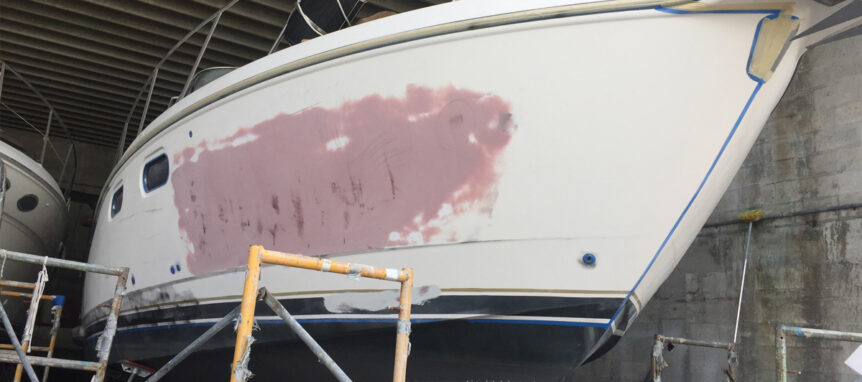Fiberglass is the structural backbone of most modern yachts. Lightweight, strong, and resistant to corrosion, it’s the preferred material for hulls, decks, and topsides. But despite its durability, fiberglass isn’t immune to damage. From hard impacts to long-term water exposure, there are a number of ways this critical material can weaken over time. Understanding the most common causes of fiberglass damage—and how to repair them properly—can help extend the life of your vessel and protect your investment.
At Horizon Marine Services, we specialize in fiberglass diagnostics, repair, and custom fabrication. Our experienced team has seen it all, and we know what it takes to restore damaged structures with lasting integrity. If you’ve noticed cracks, soft spots, or blistering on your yacht, here’s what you need to know.
The Impact of Hard Collisions
One of the most obvious causes of fiberglass damage is physical impact. Dock bumps, collisions with debris, or grounding incidents can all result in visible cracks, holes, or delamination. While some of these may seem minor, even hairline fractures can compromise the integrity of the laminate if water begins to enter the core.
Repairing impact damage starts with a thorough inspection to determine how deep the damage goes. Cosmetic cracks on the gelcoat surface may be repairable with light grinding and refinishing. However, if the impact has affected the structural layers of fiberglass beneath, more extensive restoration will be needed. This often includes cutting away the damaged material, rebuilding the layers with new fiberglass and resin, and sanding the area to blend seamlessly into the original contours.
Water Intrusion and Core Delamination
Over time, water can find its way into areas it shouldn’t—especially around deck hardware, hatches, and through improperly sealed fasteners. When water infiltrates the fiberglass and reaches the balsa or foam core, it can cause delamination. This process separates the structural layers, creating soft spots and weakening the overall integrity of the hull or deck.
Core delamination repairs typically involve removing the outer fiberglass skin, drying the area thoroughly, replacing the damaged core material, and re-laminating the structure with new fiberglass and epoxy. Proper sealing and bedding during hardware installations can prevent water intrusion from happening in the first place, which is why attention to detail during both construction and maintenance is so important.
Stress Cracks from Flex and Fatigue
Boats flex constantly as they move through the water. Over time, this flexing can lead to stress cracks in areas where the structure is under repeated load or pressure. You’ll often find these small, spiderweb-like cracks around corners, fittings, and areas with high foot traffic.
While stress cracks may not seem serious at first, they can worsen over time and eventually expose the laminate to moisture. Surface repairs can often resolve the issue, but deeper cracks that affect the laminate layers will require grinding, re-glassing, and refinishing to ensure long-term durability.
Poor Previous Repairs
Not all fiberglass repairs are created equal. In fact, one of the most common problems we see is damage caused by previous repair attempts that were done incorrectly or with the wrong materials. Filler compounds used without reinforcing fiberglass, inadequate curing times, or mismatched resins can all lead to weak spots and peeling.
When repairing an area that’s been previously patched, our team starts by removing the old material to get a clear view of the underlying structure. We then rebuild the area using proper marine-grade fiberglass and resins, ensuring a durable bond that matches the strength of the surrounding laminate. A proper repair is one that blends seamlessly—not just visually, but structurally as well.
UV and Environmental Exposure
Even without collisions or intrusions, fiberglass can degrade from long-term exposure to sunlight, moisture, and fluctuating temperatures. The gelcoat layer may fade, chalk, or develop small cracks, especially if the yacht isn’t regularly maintained or protected with wax or sealants.
Restoring weathered surfaces often involves compounding and polishing, and in more severe cases, refinishing the gelcoat or applying a new topcoat system. While cosmetic, this type of maintenance is essential for preserving the appearance and protecting the underlying fiberglass.
Choosing Professional Repair Over DIY Fixes
Fiberglass repairs require more than just patching a hole and painting over it. The process demands an understanding of composite construction, resin systems, proper lay-up techniques, and finishing work. Mistakes can be costly, especially if they compromise structural integrity or cause water to get trapped inside the laminate.
At Horizon Marine Services, our fiberglass specialists are trained to assess damage accurately and perform repairs that not only look good but hold up in real marine conditions. Whether you’re dealing with cosmetic spider cracks or serious structural issues, we take the time to do it right—using proven techniques, quality materials, and a commitment to excellence.
If you suspect fiberglass damage on your yacht, don’t wait until a small issue becomes a major one. Horizon Marine Services is here to help you restore strength, safety, and beauty to your vessel with expert repair solutions you can count on.

